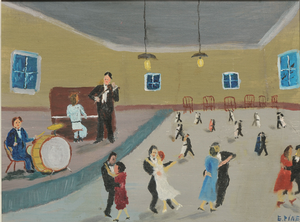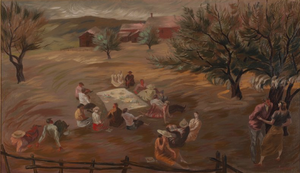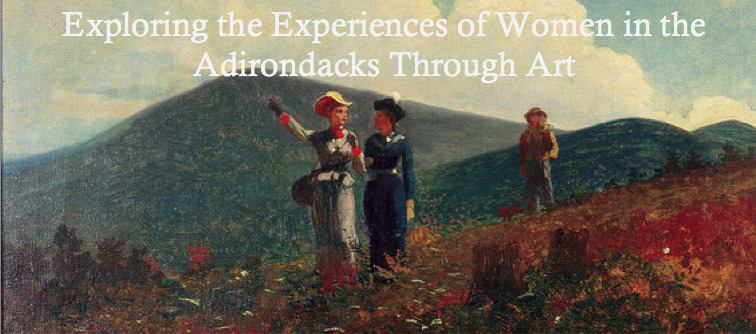
Edna West Teall was born in 1881 in Essex, New York, on Lake Champlain and spent her childhood on her family’s farm in Lewis (Jerome, vi). At age 17 she was married and moved to New Jersey, where she lived and worked for over 30 years (Adirondack Tales, xii). Upon retiring, she moved back to her hometown, where the memories of her childhood lingered, inspiring her to record the stories of her past (Adirondack Tales, vi). In her youth Teall had taught herself how to write, and in her 60s she taught herself how to paint, working first with watercolors, and later with oils (Jerome, xiii).

Teall was a modest painter, and her work was more a vehicle through which to tell a story, than that of flashy art. Though generally joyful, she used more muted and natural tones, and as she mainly painted on an easel, her works were only moderately sized (Jerome, xiii). Through her paintings and prose, Teall preserves not only her narrative, but also that of the rural Adirondacks in the 1880s.
 Teall’s work is unique to Adirondack art because it captures everyday life from a woman’s perspective. Most Adirondack art captures landscapes or people (mostly men) being adventurous: hunting, hiking, camping, or some other sort of bold activity that encapsulates the excitement of the Adirondacks. Instead of following this trend, the subjects of Teall’s paintings are a humble and unique glimpse into the hidden lives of the people of the Adirondacks. Because her works do not have an agenda beyond reliving her memories, they appear more effortlessly egalitarian and exusde a kind of peace and happiness. The main themes of her works include family, nature, and community. Many of her paintings represent domestic life and have such practical titles such as Sunday Dinner, Washday, Making Soup, and Saturday Night Bath. Teall depicts life both inside and outside the home inviting viewers into a glimpse of the past, a peak into an otherwise forgotten world. They give an intimate snapshot of what life was like in the rural Adirondacks. As is natural for one reminiscing on past memories, many of Teall’s paintings are nostalgic and idealistic, portraying life as simple and joyful.
Teall’s work is unique to Adirondack art because it captures everyday life from a woman’s perspective. Most Adirondack art captures landscapes or people (mostly men) being adventurous: hunting, hiking, camping, or some other sort of bold activity that encapsulates the excitement of the Adirondacks. Instead of following this trend, the subjects of Teall’s paintings are a humble and unique glimpse into the hidden lives of the people of the Adirondacks. Because her works do not have an agenda beyond reliving her memories, they appear more effortlessly egalitarian and exusde a kind of peace and happiness. The main themes of her works include family, nature, and community. Many of her paintings represent domestic life and have such practical titles such as Sunday Dinner, Washday, Making Soup, and Saturday Night Bath. Teall depicts life both inside and outside the home inviting viewers into a glimpse of the past, a peak into an otherwise forgotten world. They give an intimate snapshot of what life was like in the rural Adirondacks. As is natural for one reminiscing on past memories, many of Teall’s paintings are nostalgic and idealistic, portraying life as simple and joyful. 
Teall uses art as a way to tell her story and preserve the history of the Adirondacks. The Adirondacks, their culture and history, were the driving forces behind her motivation to paint. Though art became one of her mediums, she was a storyteller first. Her accounts are unique because they do not represent distinct beauty, nor are they political, but instead reflect sentiments of a bygone era. The works of Teall are a gift to those who care about the Adirondacks.
Our classmates Eliza Geeslin and Ally Kontra also discuss Teall's work on their website. Take a look: http://courses.hamilton.edu/adirondack-art/folk-art/edna-west-teall
